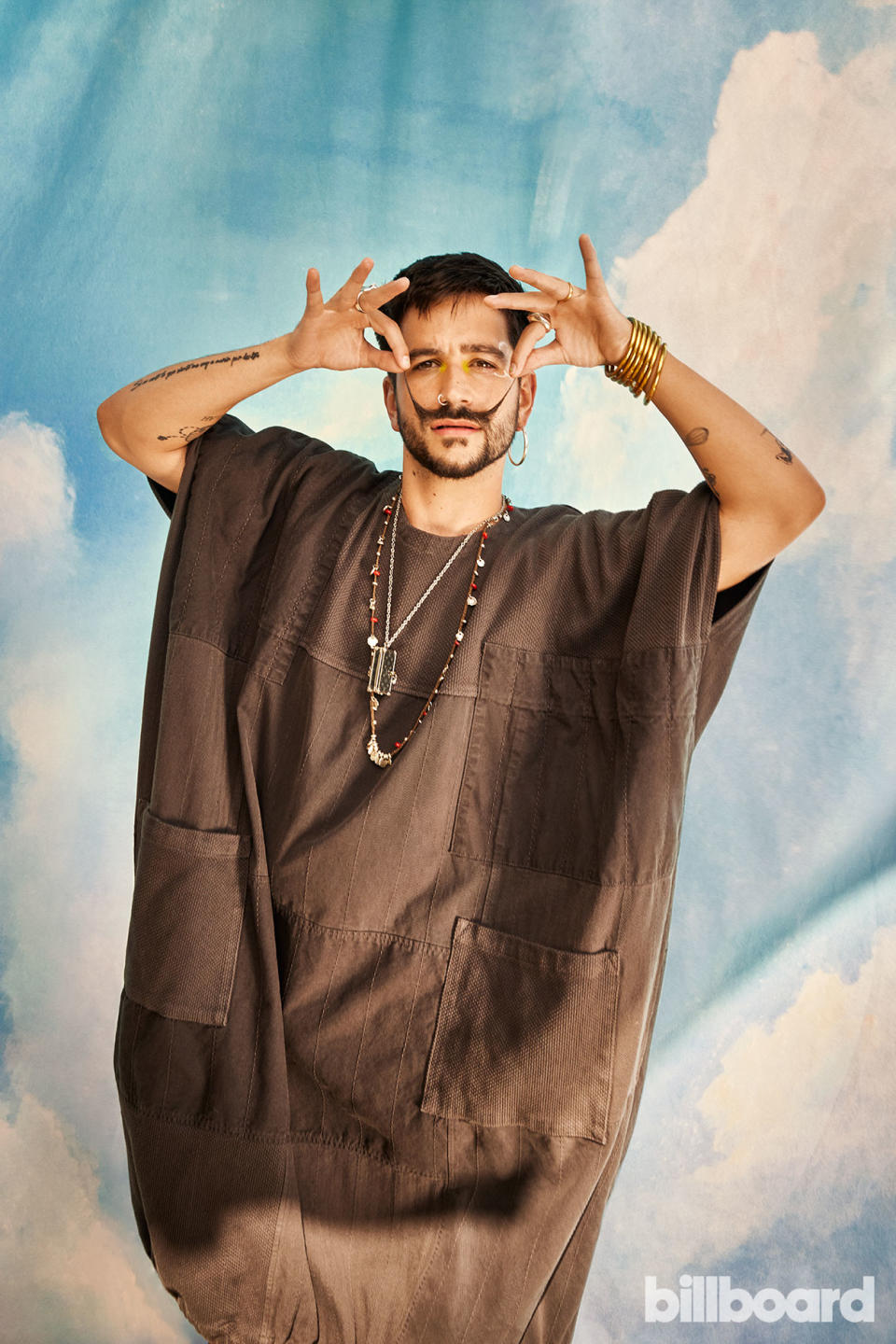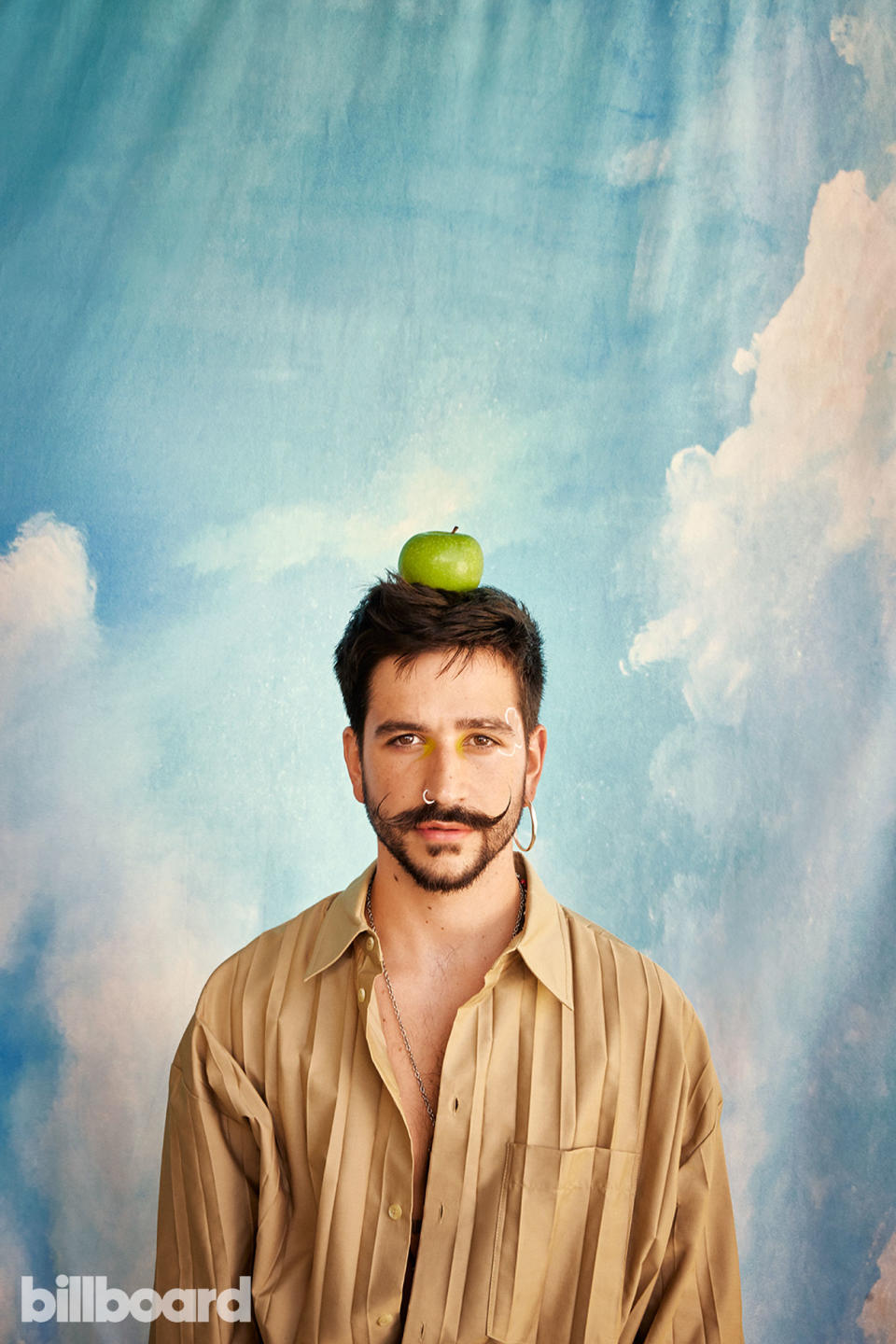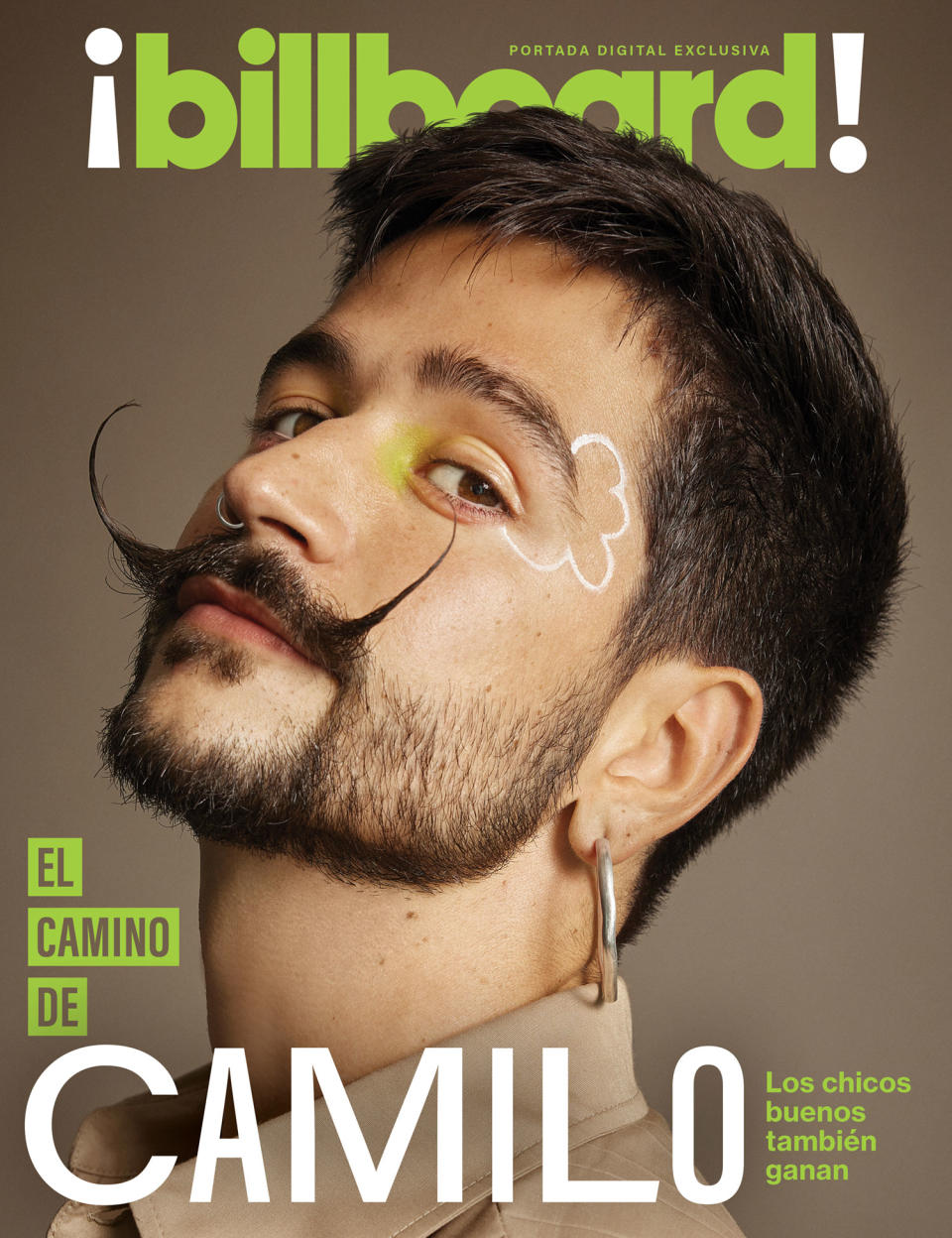The Man Behind The Moustache: Camilo’s Barefoot, Linen-Clad Journey To Latin Pop Superstardom
- Oops!Something went wrong.Please try again later.
- Oops!Something went wrong.Please try again later.

At this point in his life, Camilo could own any car he wants: a Lamborghini, a Bugatti, maybe a McLaren — all vehicles of choice among Latin music stars.
Instead, Camilo has Romerito. The word is the diminutive of the Spanish romero, which means “rosemary.” But Camilo has used it to name his car. “Because of the color,” he says with a smile, affectionately patting the front door of the olive green 1975 Ford Bronco with a beige roof that’s parked in front of Sony Music’s recording studios in Miami.
More from Billboard
Here Is the Lyric Translation to Bad Bunny & Grupo Frontera's 'un x100to'
Bad Bunny & Grupo Frontera Drop Romantic Cumbia 'un x100to': Stream It Now
Related

Camilo: Photos From the Billboard Español Cover Shoot
Romerito may look retro on the outside, but inside he’s been carefully restored, from the motor to the electric system, an expensive labor of love that took months. But Camilo had no idea how much passion it would awaken in others. In Miami, where the singer-songwriter lives with his wife Evaluna Montaner and daughter Indigo, and where driving the most expensive car possible is the order of the day, Romerito stands out — so much that Camilo had to read up on the history of the Ford Bronco in order to answer relentless questions from fellow drivers.
Like Romerito, Camilo has turned heads by virtue of what he isn’t. The songwriter wears a Dali-like moustache and silver chains instead of diamond necklaces. His melodic songs — boasting simple, yet moving and poetic lyrics — are built on guitar chords instead of computer beats. In the era of reggaetón and explicit sexual content in Latin music, songs like his “Pegao,” a romantic cumbia (“Stuck, with no air between your body and mine; stuck, like my tongue on a frozen glass”), defy every expectation of how a young act with seven No. 1s on Billboard’s Top Latin Airplay chart and three top 10s on the Pop Albums chart should sound. On Sept. 20, Camilo received six Latin Grammy nominations, including one for record of the year (“Pegao”) and two for song of the year (“Baloncito Viejo” and “Índigo,” collaborations with Carlos Vives and Evaluna Montaner, respectively).
“At the beginning of my career, I told my tribe, ‘People, the only thing I promise you is honesty,’ ” says Camilo, speaking of his close circle which he affectionately calls his tribu, a term he also uses to refer to his fans. “From that point onward, I apologize for what may come behind that door of honesty. But I’m an honest person, connected with my craft and my creativity. And the day my guitar takes me down different paths, I promise I’ll share that with you as well.”

With his third album, De Adentro Pa Afuera (Inside Out, released Sept. 6 on Sony Latin), Camilo has shared more musically daring songs, including unexpected collaborations (Myke Towers, Camila Cabello, Grupo Firme, among others) that still sound like him. The album was released amid the transcontinental concert tour that has established Camilo as an artist who not only garners millions of streams but also sells out venues. In Spain, he’s sold over 220,000 tickets this year alone, a number that, according to promoter Jorge Iglesias, makes Camilo the top-selling non-Spanish artist in that country. Camilo’s two sold-out shows at Madrid’s WiZink Center this summer, one in June and one in July, grossed $2.1 million total, according to Billboard Boxscore.
Part of Camilo’s touring success boils down to the fact that his shows, also, are just like him: Simple on the surface (he sings barefoot, walks among the crowd and is backed by a six-piece band), but ultimately profound at their core thanks to the affirmational messages in his music. Audiences ranging in age from kids to grandparents often arrive with painted faces (another Camilo trademark) and collectively sing his songs back to him, alternating between laughter and tears.
“To me, Camilo is an artist that generates total future,” says Afo Verde, president and CEO of Sony Music Latin Iberia. “He has that combination of what I loved in those artists who are true musicians and study their instrument, but with a message that’s all about values and feels from another era. He’s a young guy who talks about family and love — one love [Evaluna] — and now he adds another love, Indigo.”
Offstage, Camilo is 27-year-old Camilo Echeverry, and publicly, he’s had one girlfriend, who is now his wife. Beyond coming from Latin music royalty — Evaluna Montaner is the daughter of singer-songwriter Ricardo Montaner and younger sister of brother duo Mau y Ricky — she’s also Camilo’s muse and his personal, creative and frequent musical partner. She not only records and performs often with Camilo, including on tour, but has also directed many of his music videos and regularly collaborates with him on social media.

“In talking about Evaluna, words fall short,” says Camilo. “The word ‘love’ is uttered so very quickly. [This is] a revolutionary kind of love, a love that displaces, that breaks down structures and builds new cities, that tears down buildings and creates parks. That’s what Evaluna is. She’s like the photograph of love.”
Together, they have plenty of photos: over 125 million followers combined on social media, over 80 million of which are Camilo’s (including 28 million on Instagram and 29 million on TikTok). Those numbers reflect the couple’s astuteness when creating content. Camilo is now followed constantly by his own videographer and photographer, who have helped to document everything from the duo’s courtship to Evaluna’s pregnancy, the March birth of their daughter and now, the tour. For the artist, whose fame exploded during the pandemic after releasing his first two albums while in lockdown, these dispatches of daily life have been a boon.
“It’s been a very quick development based on songs, credibility and his live audience,” says Jorge Ferradas, who began managing Camilo in 2019. Shortly after, Ferradas was instrumental in creating the strategy behind Camilo’s first big hit, “Tutu,” a track with Pedro Capó that talks about diversity and acceptance and was later remixed with Shakira, a former Ferradas client.
“Immediately afterward, our challenge was to ensure he didn’t become ‘the ‘Tutu’ singer,’ ” says Ferradas. “From that point on, he began releasing songs that became albums, and albums that became live shows the moment the pandemic allowed it.”
Ricardo Montaner, who introduced Camilo to Ferradas, always saw the long game.
“I’ve spent 40 years in the music business, and every time I meet an artist, I visualize where he or she will be at 20 years from now,” says Montaner. “Imagining Cami 20 years from now is very easy because he’s a singer-songwriter, and those artists nourish themselves with their work. If you add to that a good voice, like Cami’s, a structure like Cami’s, you definitely have an artist with huge potential, and his career has no limits.”
Camilo looked like an artist long before he was one in his own right. When I first met him in 2018, during a “Secret Session” — one of the writing sessions put together by Sony Music to create repertoire for their recording artists — he already sported his signature moustache and distinctly bohemian style, including his trademark wide pants and linen shirts. Still, he was better-known at the time behind-the-scenes, as the co-writer of hits like Becky G and Natti Natasha’s “Sin Pijama” (which, ironically, has the kind of titillating lyrics Camilo tends to avoid).
That year, he signed as a recording artist with Sony (more on that later) and began to release music under his own name. His second single, “Tutu,” written with Jon Leone and Richi López, was his breakout hit, reaching No. 16 on Billboard’s Hot Latin Songs chart.
But Camilo’s career had really started back in 2007, when he won the Colombian kiddie competition show Factor X at age 14. He’s adorable in his audition videos and press appearances — albeit media savvy and confident, too — and he performs without visible nerves, bantering with judges and hosts and sitting down for interviews with guitar in hand, ready to sing and crack jokes. Had Camilo grown up in the United States, it’s easy to picture him in The Mickey Mouse Club.
Back then, Camilo sang covers, but Sony’s Verde, who met him on a trip to Colombia, urged him to start writing his own songs. Years later, in 2015, Camilo met Evaluna at a media event. They had a connection, and one day, Evaluna asked her famous dad — who is known for mentoring new talent — to listen to the music “from this guy I’m talking with.”
“Talking with?” Montaner recalls asking at the time. “What does that even mean?”
But he listened — and heard a high voice, like his own, singing songs “that had intention behind them. I was struck by the way he sang and the way he wrote.” Montaner took an interest in the career of his future son-in-law, and eventually knocked on multiple labels’ doors on his behalf, including Sony, with little success. Ultimately, Camilo signed a deal with Sony Music via Montaner’s label, Hecho a Mano.

Montaner also connected Camilo with Ferradas, who had just left his job as president of Univision Music and was experienced in working with both labels and artists. With Camilo, he started from scratch, but the results came quickly. A series of No. 1 hits on Latin Airplay followed “Tutu,” including “Millones” and Rauw Alejandro collab “Tattoo.” In 2021, Camilo won four Latin Grammys, becoming the year’s biggest winner.
That year, Camilo also kicked off the first tour of his life, playing 30 shows throughout Europe, Latin America, and the United States. The trek began in Spain, a destination Ferradas targeted because it was the first Latin country to loosen pandemic-era concert restrictions; by year’s end, Camilo had sold more tickets in the country than any other non-Spanish artist, and his album Mis Manos was No. 2 on Promusicae’s list of top albums of 2021.
Touring was transformative for Camilo. “There are things I confirm every night in my shows: The look in people’s eyes explains what your craft means to someone else’s life,” says Camilo. “It also shows us that songs that aren’t released are bankrupt. That what you thought was interesting, and the notion that your songs belong to you, is a lie. Your songs have value insofar as they have value in the life of people who are there. How they see those songs reveals the value of your work.”
This is particularly true of the songs on De Adentro Pa Afuera, an album conceived almost entirely while Evaluna was pregnant with Indigo and recorded during the last three months of her pregnancy.
“That process of being with Indigo from inside to outside began to generate a bunch of feelings inside me that I didn’t know I had. And seeing them made me immortalize them in songs,” says Camilo. “It was a process of, ‘Go downstairs, look at Evaluna’s belly, write a song; go downstairs, look at Evaluna’s belly and play guitar.’ They were some of the prettiest days in my life.”
Now, others are on the horizon. After launching in Spain, the Adentro Pa Fuera tour will play 30 arenas in the United States and Mexico before culminating with two December shows in Camilo’s native Colombia. In 2023, Camilo will play Latin America, beginning in Argentina and moving north, stopping in countries where he hasn’t performed before.

As his fame continues to grow, questions remain — like whether Camilo and Evaluna will ever share photos of Indigo on social media, something they’ve avoided, “because she still has no choice in the matter,” says Camilo. “If Indigo wants to be in a photo, she’ll let me know. But right now, I feel I’m interrupting her will by showing her. I’m dying to post, because there are things that I’d love to share. But out of respect for her, I’m not doing it.”
It also remains to be seen if Camilo will always be the Ted Lasso of Latin pop — perpetually good-natured and seemingly incapable of anger, frustration or any hint of arrogance. He laughs at the notion of always being Mr. Nice as he mulls it over.
“I’m not nice because I decided to be nice,” he finally says. “The only constant in me is I’m honest. Obviously, labels can be prisons, even when they’re lovely labels. The nice guy label is a prison, because creativity is indiscriminate, and the day it pushes me into an area that’s not so nice, I won’t be able to control it.”
But for now, on this Miami afternoon, Camilo is nice. He’s decided to forego a stylist or assistant (“Most times I don’t like the clothes they bring me,” he says), and has brought his own outfits, purchased from indie designers and small boutiques, for his photo shoot. He looks pleased as he walks out of his dressing room, barefoot and clad in checkered pants and a flowing shirt that may or may not have come from Evaluna’s closet. He reaches into his carry-on bag and, surprisingly, takes out a bottle of expensive cologne, an unexpected extravagance. He sprays it liberally and smiles even wider.
“It makes me feel more sure of myself,” he confides. “I do it before every concert.”
He may still drive Romerito — but even a nice guy needs a little indulgence.
This story is an English-language translation of a Billboard Español cover story.

Best of Billboard
H.E.R. & Chris Brown 'Come Through' to No. 1 on Adult R&B Airplay Chart
Anne Wilson's 'I Still Believe in Christmas' Crowns Christian Airplay Chart
Frank Sinatra, Eartha Kitt, Eagles & More: Here Are All 37 Holiday Songs on This Week's Hot 100

